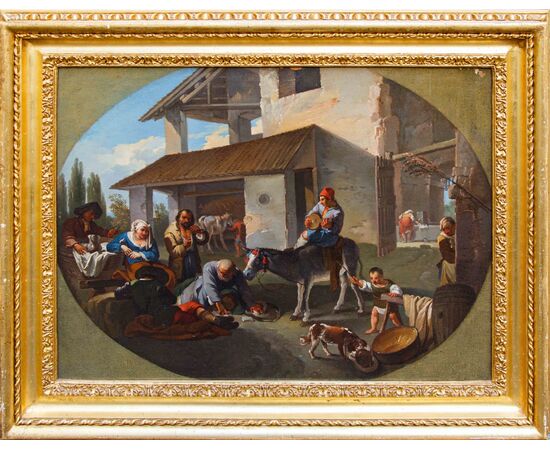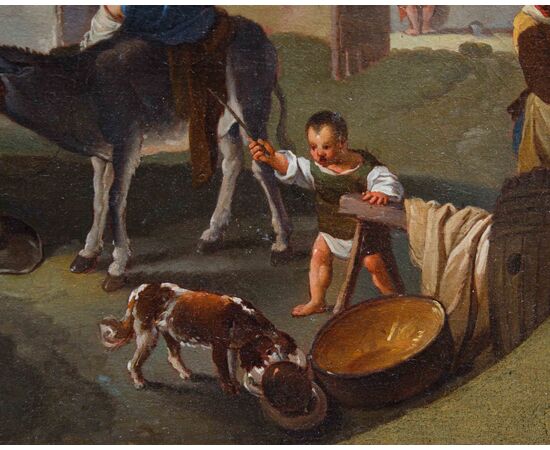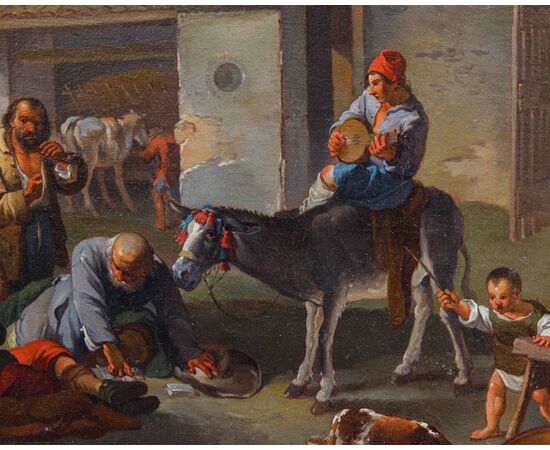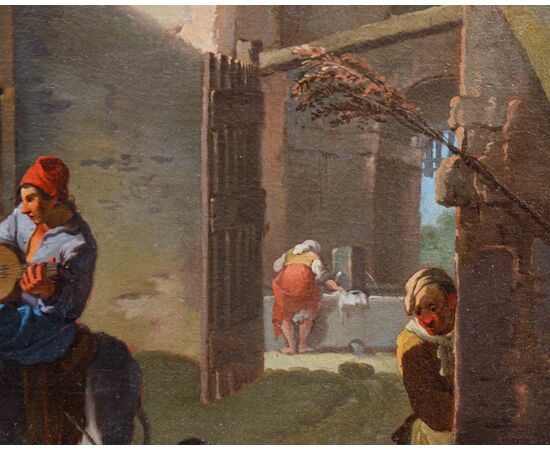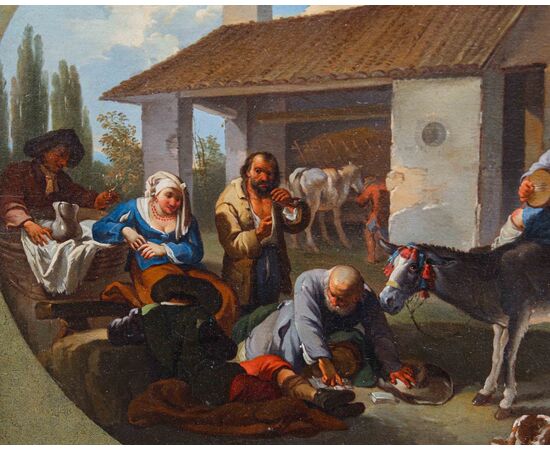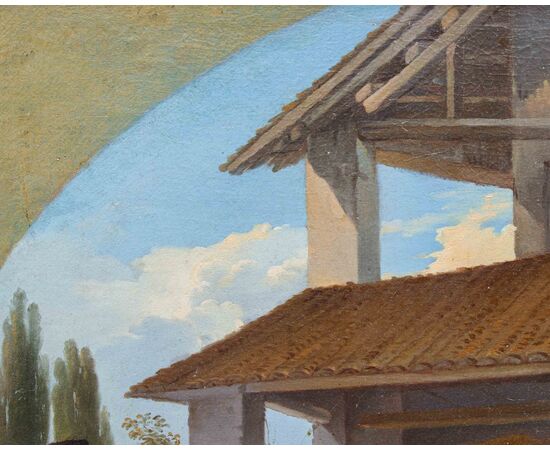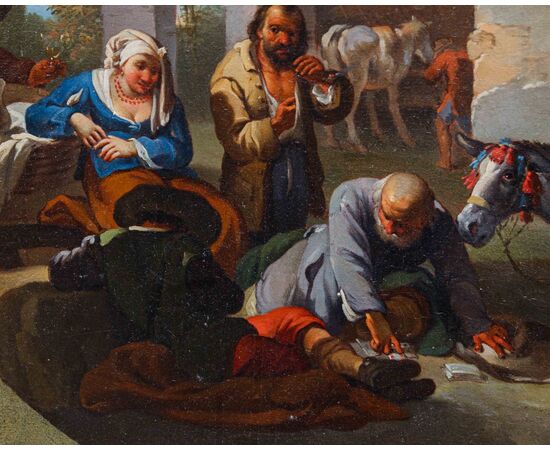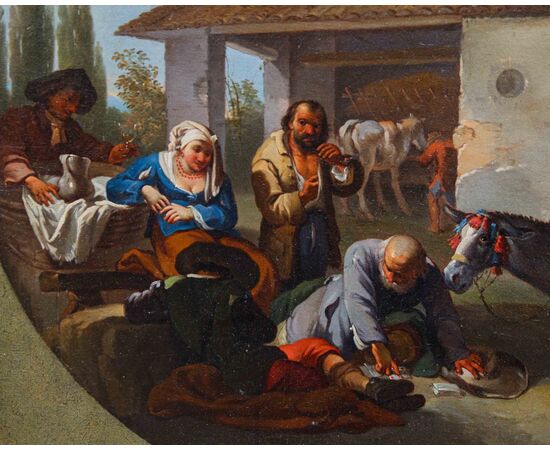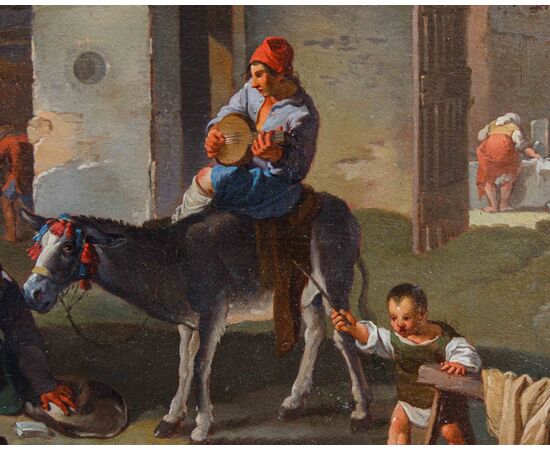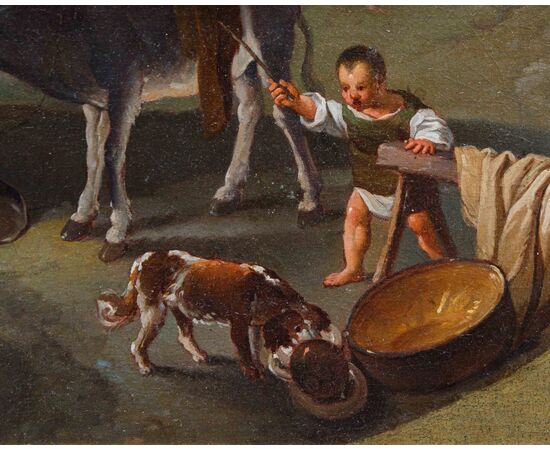Paolo Monaldi (Rome, approx. 1704 - post 1779), Genre Scene
Paolo Monaldi (Rome, approx. 1704 - post 1779)
Genre Scene
Oil on canvas, 50 x 63 cm
With frame, 65 x 80 cm
In the lively artistic panorama of eighteenth-century Rome, dominated by great names and far-reaching aesthetic trends, the figure of Paolo Monaldi emerges, a painter whose art offers a precious and fascinating glimpse into the daily life of the time. His canvases, populated by humble characters and set in recognizable scenarios of the Roman countryside or the most picturesque corners of the city, give us a vivid and frank image and an extremely valuable document to reconstruct the dictates of a world that would otherwise have been swallowed by oblivion. Biographical information on Paolo Monaldi is, unfortunately, fragmentary and not always detailed. It is known that he was active in Rome in the 18th century, but the precise dates of his birth and death are still the subject of debate among scholars. References to his training also appear very limited: it is believed that he trained with Andrea Locatelli, but there are no documents to support this thesis, postulated for the first time by Abbot Lanzi. Despite this gap, his artistic production speaks for itself, revealing a painter of remarkable technical skill and acute observational sensitivity. Monaldi dedicated himself mainly to the genre of genre painting, or "bambocciate", an artistic current that found great fortune in Rome starting from the seventeenth century, thanks above all to the influence of the Nordic painters working in the Eternal City. The so-called "Bamboccianti", for their apparently rough style and predilection for popular subjects, were opposed to academic historical and religious painting, choosing to represent scenes of common life, markets, taverns, popular festivals, brigands and travelers. Monaldi fits fully into this tradition, but with a personal touch that distinguishes him. What is striking about Monaldi is the ability to capture the essence of his subjects: the figures, while often falling into recurring types - the peasant, the washerwoman, the traveler, the musician - never appear stereotyped. On the contrary, they are rendered with a verve and vitality that suggest a deep knowledge and empathy for ordinary people. Their faces, their gestures, their clothes, often worn but rendered with great attention to detail, tell us silent stories of hard work, joy, and everyday life. The settings are equally significant. Monaldi prefers open landscapes, often with ancient ruins as a backdrop, or glimpses of city life that evoke the Rome of his time. The light in his canvases is usually clear and diffused, helping to create a serene and sometimes idyllic atmosphere, even when the subjects are linked to situations of poverty or marginalization. It is a light that enhances the earthy colors, the bright reds of the clothes, the greens of the fields, and that gives a sense of authenticity to the scenes. Among the most recurring subjects in his works are market scenes, with stalls full of fruit and vegetables, and figures intent on bargaining or simply observing. Equally famous are his representations of taverns and inns, where patrons of all kinds gather to drink, eat and socialize, often accompanied by itinerant musicians. There is no lack of scenes of rural life, with shepherds and animals, or moments of rest along the roads leading to Rome. Despite his clear membership of the bambocciata genre, Monaldi's art also shows a certain compositional elegance and attention to detail that bring him closer to more "academic" painters. His palette is rich and varied, and his brushstroke, while maintaining a freshness typical of the genre, reveals an experienced and sure hand. Paolo Monaldi was a painter who was able to observe and narrate with honesty and sensitivity the world that surrounded him: his works constitute an invaluable heritage for understanding the life, uses and customs of 18th century Rome. They remind us that art is not only a celebration of great events or illustrious figures, but can also be a powerful means to immortalize the beauty and dignity of everyday life, even that of the most humble people. Among Monaldi's most refined works, it is worth mentioning the painting depicting Cavallo Aquilino, formerly from the Rospigliosi collection, now preserved in the Museo di Roma in Palazzo Braschi, which bears the author's initials and the date 1757. Beyond the numerous paintings with peasant scenes set in the Agro Romano and passed through the Italian and international antique market, it is worth mentioning the ovals depicting the Visit to the Farm of the Musée des beaux-arts in Bordeaux and the Dance of Peasants of the Musée d'art et d 'archéologie of Périgueux. The artist's best known cycle, however, remains that created between 1766 and 1771 for the suburban villa of Cardinal Flavio Chigi, partly executed in collaboration with Paolo Anesi.
Our painting represents an interesting testimony to Monaldi's bambocciante production: it shows all the distinctive traits of the painter's production. The canvas features the rough realism, devoid of pietism, of the representation of popular figures and the choice of a serene and reassuring palette, characteristic of the Roman painter's corpus.

